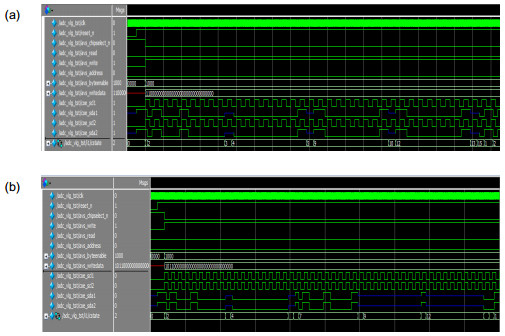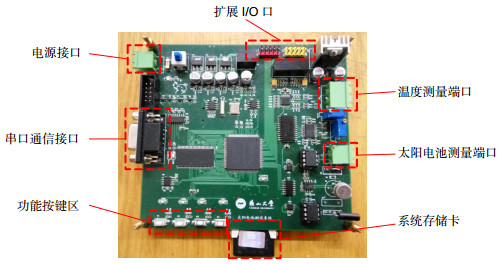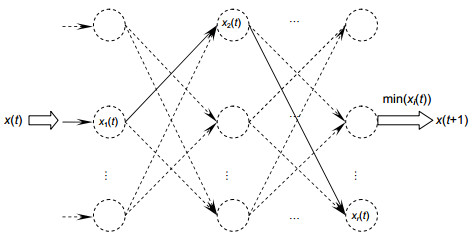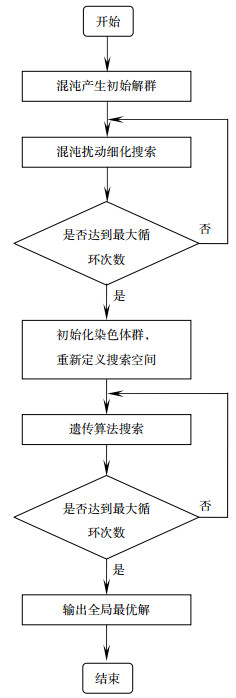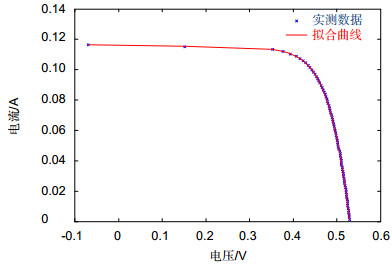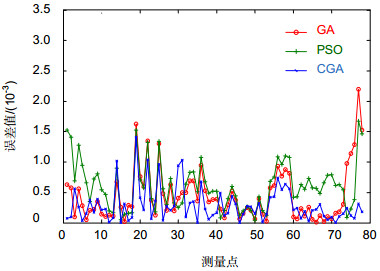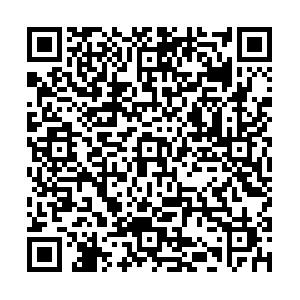-
摘要
高空条件下太阳电池特性测试对于研究航天用太阳电池具有重要意义。本文提出了一种高空太阳电池Ⅰ-Ⅴ特性曲线测量方案,研究基于FPGA的硬件测试系统、并行数据采集测量方式和系统软件自动测量方法。提出基于混沌算法与遗传算法融合的太阳电池Ⅰ-Ⅴ特性曲线拟合算法。针对地面测试实验数据,利用太阳电池单二极管数学模型进行曲线拟合计算,结果表明混沌遗传算法优化结果适应度值为4.0289×10-4,曲线拟合效果优于粒子群算法和遗传算法。

Abstract
The high altitude calibration of solar cells is of great significance to study solar cells for space application. This paper presents a measurement scheme to measure the Ⅰ-Ⅴ curves of solar cells at a high altitude. The paper studies the hardware testing system based on FPGA, the method of acquiring the current and voltage data in parallel and the automatic measurement method of software in this system. An algorithm for fitting the current-voltage curve of solar cells based on chaos algorithm and genetic algorithm is proposed. According to the experimental data of ground testing, the curve fitting algorithm is carried out by using solar cell single diode mathematical model. The results show that the fitness value of the chaos genetic algorithm is 4.0289×10-4, which means that the curve fitting is better than particle swarm algorithm and genetic algorithm.
-
Key words:
- solar cell /
- Ⅰ-Ⅴ characteristic test /
- chaos genetic algorithm /
- curve fitting
-
Overview

Abstract: Solar cell is an important part of the energy of spacecraft, and the accurate calibration of solar cell can provide data reference for the assembly of solar panels. The ground solar simulator may bring in error, and can't accurately reflect the performance of solar cell under conditions of high altitude, which may have a bad impact on the applications of solar cell in space. So it has a very important significance to research calibration technology of the solar cell under conditions of high altitude. Originated in the United States, high altitude solar cell calibration technology is mainly applied to study the performance of solar cells in high-altitude environment. Initially, characteristics of the short-circuit current of the solar cell were studied in the high altitude, and then with the development of science and technology, the Ⅰ-Ⅴ characteristic curve of the solar cell was measured. China is still in the primary stage of high altitude solar cell calibration technology, and only two kinds of exploratory solar cells short-circuit current tests were carried out.
Taking the imperfection of high altitude solar cell testing technology, and insufficiency of theoretical research into consideration, we focused on the key technologies of high altitude solar cell testing and calibration methods. Research for the power generation mechanism and electrical characteristics of the solar cell was carried out. According to the test environment, the key technologies and methods of Ⅰ-Ⅴ characteristics of solar cells in high-altitude environment were introduced. An Ⅰ-Ⅴ characteristic test system based on programmable electronic load for solar cells was designed, which could execute tests on solar cell automatically.
According to the measurement error of experimental data, the curve fitting algorithm was developed to get more accurate Ⅰ-Ⅴ curve data. On the basis of the analysis of equivalent mathematical model of solar cells, a method based on chaotic genetic algorithm was proposed to fit the Ⅰ-Ⅴ curve of solar cells. In view of the solar cell's Ⅰ-Ⅴ characteristics data, the algorithm, which provided the value of the parameters of the equivalent mathematical model, was executed to achieve curve fitting. The fitness value of the chaos genetic algorithm is 4.0289e-4. The comparison results show that curve fitting with chaotic genetic algorithm is better than particle swarm algorithm and genetic algorithm. Based on the equivalent mathematical model of solar cell, the characteristic parameters of solar cells corresponding to experimental conditions can be calculated.
-

-
表 1 算法对比.
Table 1. Algorithm comparison.
Algorithm GA PSO CGA Iph/A 0.11779 0.11758 0.11606 ISD/μA 0.43747 0.49006 0.06546 n 1.65982 1.67546 1.44324 Rs/Ω 0.04234 0.02183 0.10352 Rsh/Ω 303.839 185.985 239.432 RMSE 6.1302e-4 7.1745e-4 4.0289e-4 表 2 太阳电池特性参数.
Table 2. Characteristic parameters of solar cell.
Parameters Value Isc/A 0.11601 Voc/V 0.53004 Pm/W 0.04478 Im/A 0.10506 Vm/V 0.42627 FF 0.7283 -
参考文献
[1] 洪雷.卫星太阳电池阵模拟器工作模式研究[J].航天器工程, 2015, 24(3): 125–130. http://www.wanfangdata.com.cn/details/detail.do?_type=perio&id=htqgc201503020
Hong Lei. Study on operation mode of satellite solar array simulator[J]. Spacecraft Engineering, 2015, 24(3): 125–130. http://www.wanfangdata.com.cn/details/detail.do?_type=perio&id=htqgc201503020
[2] Bailey S, Snyder D, Jenkins P, et al. Standards for space solar cells and arrays[C]. Proceedings of Seventh European Space Power Conference, Stresa, Italy, 2005: 575–580.
http://publica.fraunhofer.de/documents/N-172141.html [3] Hoheisel R, Wilt D, Scheiman D, et al. AM0 solar cell calibration under near space conditions[C]// Proceedings of the 40th Photovoltaic Specialist Conference, Denver, CO, USA, 2014: 1811–1814.
https://ieeexplore.ieee.org/document/6925274/ [4] 刘福才, 赵阳, 杨亦强, 等.高空气球太阳能电池标定用太阳跟踪控制技术[J].航空学报, 2014, 35(11): 3137–3144. http://industry.wanfangdata.com.cn/dl/Detail/Periodical?id=Periodical_hkxb201411024
Liu Fucai, Zhao Yang, Yang Yiqiang, et al. Sun tracking tech-nology for balloon flight solar cell calibration[J]. Acta Aeronautica et Astronautica Sinica, 2014, 35(11): 3137–3144. http://industry.wanfangdata.com.cn/dl/Detail/Periodical?id=Periodical_hkxb201411024
[5] 张亚, 袁亚飞, 汤浩军.太阳电池空间标定技术初探[J].宇航计测技术, 2010, 30(1): 28–32. http://www.wanfangdata.com.cn/details/detail.do?_type=perio&id=yhjcjs201001007
Zhang Ya, Yuan Yafei, Tang Haojun. Primary investigation of the AMO solar cell space calibration[J]. Journal of Astronautic Metrology and Measurement, 2010, 30(1): 28–32. http://www.wanfangdata.com.cn/details/detail.do?_type=perio&id=yhjcjs201001007
[6] Lo E B W, Phelps R, Michael S. Evaluation and testing of the solar cell measurement system onboard the naval postgraduate school satellite NPSAT1[C]. Proceedings of the 22nd AIAA International Communications Satellite Systems Conference & Exhibit, Monterey, California, 2004: 2004–3267.
https://www.researchgate.net/publication/268573158_Evaluation_and_Testing_of_the_Solar_Cell_Measurement_System_Onboard_the_Naval_Postgraduate_School_Satellite_NPSAT1 [7] 刘民, 杨亦强, 袁亚飞.航天器太阳电池阵电性能测试技术[J].航天器环境工程, 2010, 27(2): 153–156. http://www.wanfangdata.com.cn/details/detail.do?_type=perio&id=htqhjgc201002005
Liu Min, Yang Yiqiang, Yuan Yafei. The measurement & test techniques for electrical performances of the spacecraft solar cell arrays[J]. Spacecraft Environment Engineering, 2010, 27(2): 153–156. http://www.wanfangdata.com.cn/details/detail.do?_type=perio&id=htqhjgc201002005
[8] 王志明, 唐冬梅, 魏光普.用IRAGA与ACA融合算法拟合太阳电池Ⅰ-Ⅴ曲线[J].太阳能学报, 2013, 34(6): 1034–1038. http://kns.cnki.net/KCMS/detail/detail.aspx?filename=tylx201306018&dbname=CJFD&dbcode=CJFQ
Wang Zhiming, Tang Dongmei, Wei Guangpu. Correlating Ⅰ-Ⅴ curve of solar cells with combination algorithm of IRAGA and ACA[J]. Acta Energiae Solaris Sinica, 2013, 34(6): 1034–1038. http://kns.cnki.net/KCMS/detail/detail.aspx?filename=tylx201306018&dbname=CJFD&dbcode=CJFQ
[9] Alam D F, Yousri D A, Eteiba M B. Flower pollination algorithm based solar PV parameter estimation[J]. Energy Conversion and Management, 2015, 101: 410–422. doi: 10.1016/j.enconman.2015.05.074
[10] Gong Wenyin, Cai Zhihua. Parameter extraction of solar cell models using repaired adaptive differential evolution[J]. Solar Energy, 2013, 94: 209–220. doi: 10.1016/j.solener.2013.05.007
[11] Askarzadeh A, Rezazadeh A. Parameter identification for solar cell models using harmony search-based algorithms[J]. Solar Energy, 2012, 86(11): 3241–3249. doi: 10.1016/j.solener.2012.08.018
[12] El-Naggar K M, Alrashidi M R, Alhajri M F, et al. Simulated annealing algorithm for photovoltaic parameters identification[J]. Solar Energy, 2012, 86(1): 266–274. https://www.sciencedirect.com/science/article/pii/S0038092X11003586
[13] Chen Zhicong, Wu Lijun, Lin Peijie, et al. Parameters identification of photovoltaic models using hybrid adaptive Nelder-Mead simplex algorithm based on eagle strategy[J]. Applied Energy, 2016, 182: 47–57. doi: 10.1016/j.apenergy.2016.08.083
[14] Yuan Xiaofang, Xiang Yongzhong, He Yuqing. Parameter extraction of solar cell models using mutative-scale parallel chaos optimization algorithm[J]. Solar Energy, 2014, 108: 238–251. doi: 10.1016/j.solener.2014.07.013
[15] 肖容. 基于FPGA的高精度光伏测试仪的研究[D]. 武汉: 华中科技大学, 2012.
Xiao Rong. Research on the high accuracy test system for PV cell/array based on FPGA[D]. Wuhan: Huazhong University of Science and Technology, 2012.
http://cdmd.cnki.com.cn/Article/CDMD-10487-1013013713.htm [16] 俎云霄, 周杰.基于组合混沌遗传算法的认知无线电资源分配[J].物理学报, 2011, 60(7): 079501. http://www.wanfangdata.com.cn/details/detail.do?_type=perio&id=wlxb201107131
Zu Yunxiao, Zhou Jie. Cognitive radio resource allocation based on combined chaotic genetic algorithm[J]. Acta Physica Sinica, 2011, 60(7): 079501. http://www.wanfangdata.com.cn/details/detail.do?_type=perio&id=wlxb201107131
[17] 王仲民, 戴怡, 赵辉.混沌遗传混合算法及其在弹簧剪应力校核中的应用[J].兵工学报, 2009, 30(8): 1143–1146. http://www.cnki.com.cn/Article/CJFDTOTAL-BIGO200908028.htm
Wang Zhongmin, Dai Yi, Zhao Hui. Chaos genetic hybrid algorithm and its application to shear stress verifying of spring[J]. Acta Armamentarii, 2009, 30(8): 1143–1146. http://www.cnki.com.cn/Article/CJFDTOTAL-BIGO200908028.htm
-
访问统计


 E-mail Alert
E-mail Alert RSS
RSS
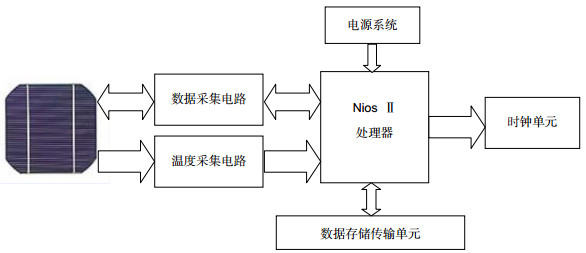
 下载:
下载:
